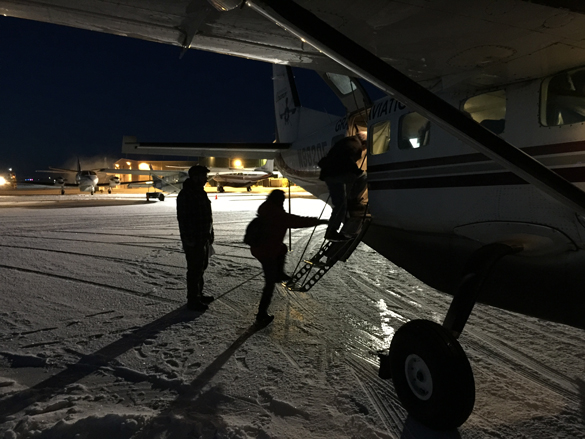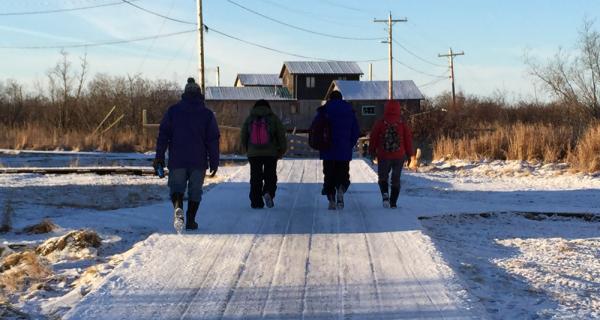A Fearless Fight Against Historical Trauma, the Yup’ik Way
They were building the young man’s coffin in the front yard when we arrived. Portable construction lights harshly illuminated the scene as men worked in the shadowy dawn that lasts almost until noon out here on the tundra. The men worked steadily and quietly in a manner that suggested front-yard coffin construction was a routine task. I soon learned that it was.
We arrived about 30 minutes earlier via a shaky nine-seat bush plane, the only way in and out of most villages here on the Yukon Kuskokwim Delta east of Bethel, Alaska. There are over 50 Yup’ik villages on this great frozen sponge of a place, where the great flat expanse of land leading to the Bering Sea is actually just permafrost and thus, constantly shifting.
RELATED: Gallery: Fighting Against Historical Trauma, the Yup’k Way
Ray Daw, Navajo, director of Behavioral Health for the tribally owned Yukon Kuskokwim Health Corporation (YKHC) and Rose Domenic, Yup’ik Director of the corporation’s Behavioral Health Prevention Department and leader of Calricaraq invited me along to observe this unique rapid response trauma intervention in action. Calricaraq means (Healthy Living) in Yup’ik and is unlike any other mental health professional intervention team. In addition to those trained in traditional western behavioral health, it includes a group of Yup’ik elders with extensive knowledge of their language and culture. Daw, the first Native director for Behavioral Health describes the expertise of the Calricaraq team as heart skills that can’t be learned from books. “Western interventions are built primarily from books and depend on certification and a system that manages individual behavior by relying on an expert,“ he said. “That system is shunned by our elders and seen as a way to mask issues that individuals may have, issues that need to be addressed and cared for.”
The entire Calricaraq team is Yup’ik and although much of what took place during this intervention was conducted in the Yup’ik language, I was able to follow the flow of events and human drama as it played out. English-speaking team members translated for me when they could.
A man seated on a four-wheeler was waiting for us as our plane bounced down onto the barren airstrip. Clearly overwhelmed by grief, he wordlessly threw his arms around the first member of our group to emerge from the plane, Sophie Jenkins, Yup’ik of the Calricaraq team. The man was the father of the young man who had recently been stabbed to death by another relative, the young man’s niece. Both the attacker and her victim were 19 years old. Since both families entwined by this domestic tragedy requested anonymity to protect their privacy and their grief, I will refer to the family of the deceased as “B.”
The murder was a senseless crime. A now-forgotten argument, fueled by alcohol and maybe drugs escalated into blind rage, and the young woman stabbed her uncle to death. They had grown up together, the niece often staying at the B family home.
It was around 8 degrees that day and although I was raised in Wisconsin, a state with harsh winters, I sensed something different about this cold. It was serious cold. The crystalline clear light all around us was stark and the dry air made everything seem brittle and sharp. The rustic little village seemed imbued with a dangerous kind of beauty; I sensed immediately that this was a climate that demanded respect.

We made our way over the warren of narrow wooden boardwalks that serve as sidewalks out in the village and finally stomped the snow from our boots before entering the B home.
Like all homes here, it is a modest wooden structure on stilts to protect the permafrost. Today it was filled to bursting with extended family and friends who had come to pay their respects at the boy’s wake.
We entered the main room, where an elder, the victim’s grandma, pulled hopelessly mismatched socks onto the feet of a wriggling little girl. I learned later that this was the victim’s daughter. The grandma, who looked to be in her late 70s or early 80s, wore an expression of stunned exhaustion; she moved as though in a daze. Many of the adults in the room wore similar expressions. Children would periodically wander into the room, and seem confused by the somber tone of the gathering. A sleepy teenager stumbled in from some deep corner of the home and made a beeline for a huge box of donuts on the kitchen table.
Calricaraq team member Mardy Hanson, Yup’ik sat between the grandma and another elder woman of about the same age. There was clearly some undefined tension between the two elders, and I watched them closely. The second elder woman especially drew my attention. Her eyes were clear. Although she said nothing, she exuded a calm courage that was both inspiring yet humbling. I would learn more about this remarkable woman later.
We sat in a circle and the team began their work. They spoke of their similar experiences, often crying, and shared painfully personal details of their struggles to survive trauma. The team’s elders spoke of the guiding principals of the Yup’ik systems of living that include the potent medicine of qaruyan (healing) and moreover of kaholian (unconditional love and understanding).
“Our ancestors gave us tools to understand our minds and name our feelings,” one told the group. “Our subsistence way of life, the very act of surviving and providing food for our families is also an important means for healing. We say that true healing can be found on the tundra.”
Read more at http://indiancountrytodaymedianetwork.com/2015/03/16/fearless-fight-against-historical-trauma-yupik-way-159611
